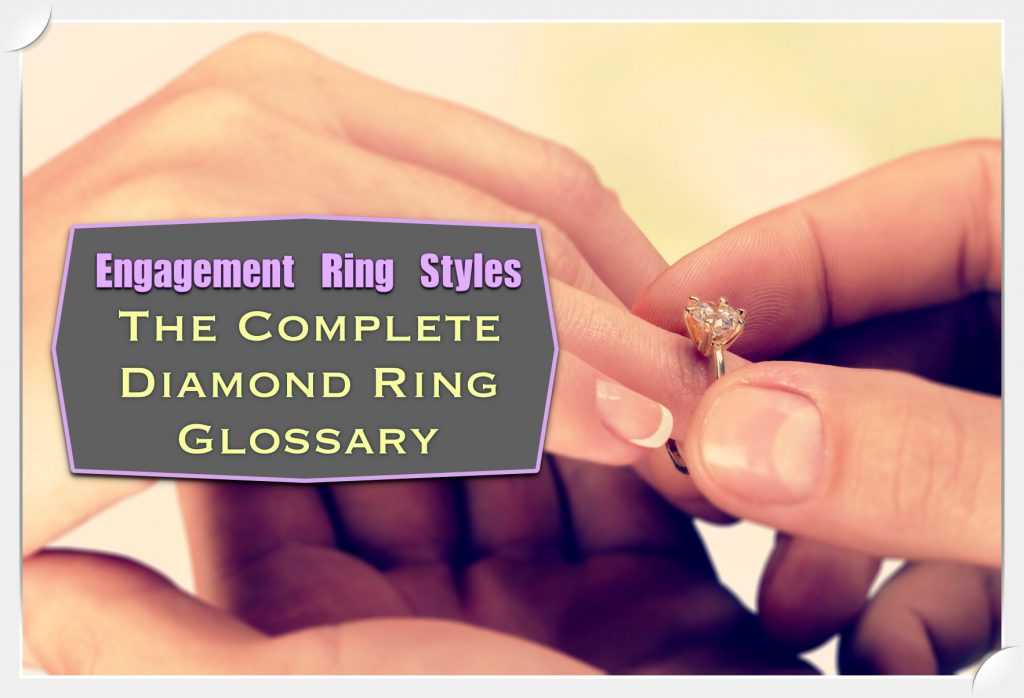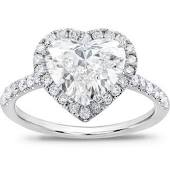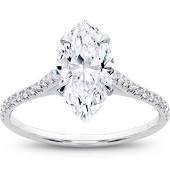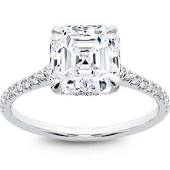Reference this complete diamond ring glossary for a better understanding of engagement ring styles.
You and your loved one are talking marriage, and that has you dreaming up the perfect engagement ring.
There are more than a few engagement ring styles to choose from, and you want to find the one that suits you (or your loved one) best.
Curious to know what’s out there? Hoping to get the diamond ring lingo down before you start shopping for yourself, or your loved one?
In any case, our diamond ring glossary has it all.
Here’s What You Need to Know About Engagement Ring Styles…
Understanding Diamond Quality
The Four Cs
Created by the Gemological Institute of America, the four Cs are the four characteristics to consider when evaluating and purchasing a diamond.
Cut
The cut accounts for a diamond’s proportion, symmetry, and polish.
The diamond’s cut affects its brilliance (the brightness of the white light reflections on the surface and inside), fire (the dispersion of the white light, registered to our eyes as flashes of color), and scintillation (the sparkles seen when it moves in the light).
Color
Diamonds come in a variety of colors – white, blue, pink, and even yellow.
Pure, or nearly pure, diamonds are colorless and have the highest color ratings. Diamonds with traces of yellow, gray, and brown are rated less highly.
Diamond colors like blue, pink, and yellow, are graded on their own scale. Usually the more vibrant their natural tone, the more valuable the stone and the better the color rating. Since they’re rare, these fancy diamonds can be even more valuable than the pure colorless diamonds with the highest color ratings.
Clarity
Diamonds are like snowflakes. Each one is different.
Formed by extreme heat and pressure deep within the earth, they come with small imperfections on their inside (inclusions) and on their surface (blemishes).
The clarity assesses the extent to which these inclusions and blemishes are present.
The more inclusions and/or blemishes a diamond has, the less brilliantly it will shine. This is because these marks interfere with the light’s pathways through the diamond.
At the same time, though, a couple microscopic inclusions can make your diamond unique. It’s all in the balance.
Carat
Most think of carat as size. But carat is technically a unit of weight. It’s the most common unit of weight that diamonds are measured and sold in. 1 carat equals 0.2 grams.
Unlike the other 3 Cs, a diamond’s carat rating is not always so proportional to its value. A larger diamond may have large inclusions and blemishes or a lackluster color grade. This can drive the price below a smaller diamond of top-notch clarity and color.
Some more diamond terms that are useful to know…
- Crown – the top half of the diamond
- Pavilion – the bottom half of the diamond
- Table – the flat surface that is the uppermost part of the diamond
- Facets – the smooth surfaces that have been cut, polished, and angled to reflect light
Understanding Diamond Shapes
Diamonds can be cut into many shapes, like…
Round
A round diamond with 58 facets is the most common diamond cut.
Princess
A princess diamond is a square- (sometimes rectangular-) shaped diamond. It is the most common fancy diamond cut.
Oval
An oval-shaped diamond is still classic, like the round shape, but just a touch more distinctive.
Marquise
A marquise diamond is an oval-shaped diamond with pointed ends.
Pear
A pear-shaped diamond combines the round and marquise shapes. Only one side is pointed.
Emerald
An emerald diamond is a rectangular-shaped diamond with small rounded edges, long tiered facets, and a large table.
Asscher
An asscher diamond is a square-shaped diamond with step facets to a high crown and a small table.
Radiant
A radiant diamond is a square- or rectangular-shaped diamond with minimal rounding of the edges.
Cushion
A cushion diamond is a square-shaped diamond with rounded edges, like a pillow.
Heart
A heart-shaped diamond is an ultimate symbol of true love and romance.
The shape of the diamond will determine so much about diamond size and the ring setting. So, think about shape first.
And if you’re buying for your loved one, ask about their shape preference. You wouldn’t want to choose a larger fancy diamond if your loved one has dreamed of a petite classic round for as long as they can remember.
Understanding Ring Band Metals
Ring bands can be made from many metals, like…
Yellow Gold
Yellow gold is a pure gold alloyed with yellow metals like copper and zinc to produce a yellow color.
Like all gold, yellow gold is measured for purity in karats (not to be confused with carats). The higher the karat count, the purer the gold content and the softer the metal. 14k (just shy of 60% pure gold) and 18k (about 75% pure gold) are the most common counts for engagement and wedding bands. 14k bands are lighter and more durable, while 18k bands are weightier and more precious.
Historically, yellow gold is the most common color for engagement and wedding bands.
Yellow Gold Metal Tip:
The purest of the gold colors, yellow gold is the most hypoallergenic gold choice, so the safest gold choice for those with sensitive skin.
White Gold
White gold is a pure gold alloyed with some white metals like nickel to produce a white/silver color.
These days, white gold is as popular as traditional yellow gold for engagement and wedding bands.
White gold is cheaper than platinum, another popular white/silver metal.
White Gold Metal Tip:
If you have a sensitivity to nickel, white gold might give you an allergic reaction.
Rose Gold
Rose gold is a pure gold alloyed with copper to produce a rose color.
It’s not as common as white gold and yellow gold, so it’s usually cheaper than similar yellow and white gold options.
Rose Gold Metal Tip:
If you have a sensitivity to copper, rose gold might give you an allergic reaction.
Platinum
Platinum is a naturally white/silver colored metal, which may also be combined with a small amount of other white/silver metals. Anything less than 95% platinum is considered a platinum alloy.
It’s a very dense metal that is stronger and more valuable than gold. The finest jewelry metal around, it rings in at a premium price point.
Platinum Metal Tip:
It’s the most hypoallergenic choice of the four metal types.
Two-Tone
Can’t choose just one band metal? You can always mix and match your ring.
On Engagement Ring Settings
You’ve got a sense of the diamond shape and size plus the band metal you want. How will you bring the diamond and band together in a setting?
Engagement rings come in many settings, like…
Solitaire
A solitaire setting features a single central diamond secured to the band by prongs or a bezel. It’s the most common of all engagement ring styles, so perfect for someone who loves a classic look.
Halo
A halo setting features a single central diamond surrounded by a ring of smaller diamonds. This ring of smaller diamonds makes the central diamond appear bigger and give the ring lots of shine.
Pave
A pave setting features a band that is paved with tiny diamonds. The band is fully or partially paved. Either way, the path of tiny diamonds winds toward the central diamond(s). A pave setting is about as sparkly as an engagement ring gets.
Three Stone
A three-stone setting features a central diamond flanked by two smaller diamonds on either side. The smaller the side stones are the larger that central diamond will appear.
Gemstone
A gemstone setting features a gem other than a diamond, or a mix of diamonds and other gems. A common gemstone setting is a three stone setting with the central diamond flanked by two non-diamond gems. The color of these gems pop, and help the central diamond pop a bit more, too.
Split-Shank
A split-shank setting is a band that splits apart as it reaches the central diamond. There’s visible space between the band and the featured diamond, which can make that diamond appear fuller. Often this setting is paired with a pave setting. The split band has even more surface area for the paving of tiny diamonds – and, so, even more sparkle.
Modern
A modern setting steps outside the most common engagement ring styles by mixing and matching them in original ways. It’s usually an angular look, too. So if you’re (or your loved one is) someone looking to stand out a bit, and who likes straight lines more than curves, see what you can find or design yourself.
Vintage
A vintage setting is best for someone who wants to throw it back. Like a modern setting, they’re a good way to stand out from the crowd. That said, they’re usually daintier and softer looking than modern settings, especially where the band design is concerned.
Need some help finding or creating the perfect engagement ring?
We’ve helped many couples, who are now happily married, with their engagement ring styles search. And we want to make your engagement ring dreams come true next.
Work with us to find your favorite engagement ring style, or to combine some of your favorite engagement ring styles to create something spectacularly you (or your loved one). With help from our experts, you can create an engagement ring that no one else has.
All our diamonds are conflict-free and certified by the best, and we love talking about them.
So, please get in touch.




